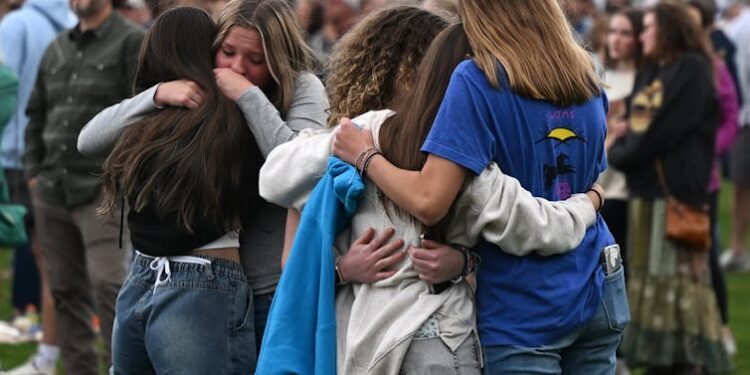On Sept. 10, 2025, the nation’s attention was riveted by the fatal shooting of the conservative activist Charlie Kirk on a college campus in Utah. At nearly the exact same time, a state away − in Colorado − an active shooting was underway on a high school campus in a sleepy mountain town, leaving two teens in critical condition and the shooter, a fellow student, dead from a self-inflicted gunshot.
While differing in context, these events share devastating commonalities that will haunt many Americans for decades and possibly generations to come. And they are only the latest of a very long string of violent acts, some politically motivated and some motivated simply by the intention to harm as many people as possible.
I am a trauma psychiatrist and researcher, and I know that the direct and indirect effects of such violence reach millions. While those in the immediate surroundings are most affected, the rest of society suffers, too.
Table of Contents
First, the immediate survivors
No two people experience exposure to public violence in the same way. The extent of the trauma, stress and fear can vary, depending on variables ranging from someone’s genetic makeup to where they were during the incident, and what they saw and heard. A hallmark of exposure to such life-threatening experiences is post-traumatic stress disorder.
PTSD is a debilitating condition that develops after exposure to serious traumatic experiences such as war, natural disasters, rape, assault, robbery and gun violence. Nearly 8% of the U.S. population deals with PTSD. Symptoms include high anxiety, avoidance of reminders of the trauma, emotional numbness, hypervigilance, frequent intrusive memories of trauma, nightmares and flashbacks. The brain switches to fight-or-flight and survival mode, and the person is always waiting for something terrible to happen. Survivors of a shooting may avoid the neighborhood where the shooting occurred or the contexts related to the shooting.
When the trauma is caused by people, as in a public shooting, the impact can be profound. The rate of PTSD in people directly exposed to mass shootings may be as high as 36% among survivors. Depression, another debilitating psychiatric condition, occurs in as many as 80% of people with PTSD. Because of the human nature of such events, avoidance often extends to all public situations. In my work as a psychiatrist, I often see people with PTSD socially debilitated to the point they cannot leave home even for grocery shopping.
People may also experience survivor’s guilt, the feeling that they failed others who died or did not do enough to help them, or just guilt at having survived.
PTSD can improve by itself, but many people need treatment. The more chronic PTSD is, the more negative the impact on the brain. Hence, it is important for those who are exposed to receive proper screening, prevention and care when needed.
Psychotherapy and medications offer effective treatments. And new advances in artificial intelligence and mixed reality technologies are allowing me and other clinicians to help people feel safe again in public situations through simulations in the clinic.
Children and adolescents, who are developing their worldview and learning how safe it is to live in this society, may suffer even more. Exposure to horrific experiences such as school shootings or related news can fundamentally affect the way children and youth perceive the world as a safe or unsafe place.
They can carry such a worldview for the rest of their lives and transfer it to their children. Research is also abundant on the long-term detrimental impact of childhood trauma on a person’s mental and physical health through their adult life.
RJ Sangosti/MediaNews Group & The Denver Post via Getty Images
The effect on those close by or arriving later
PTSD can also develop via indirect exposure to others’ severe trauma. People in the vicinity of a shooting may see exposed, disfigured or dead bodies. They may also see injured people in agony, hear extremely loud noises and experience chaos and terror after the shooting.
A group whose chronic exposure to horrific trauma is often overlooked is the first responders. While survivors try to run away from an active shooter, the police, firefighters and paramedics rush into the danger zone. In addition, dispatchers hear firsthand the highly disturbing details of the event as it is underway but may not receive the support needed to process the events.
Many first responders might have their own children in that school or nearby. They frequently face uncertainty; threats to themselves, their colleagues and others; and terribly upsetting post-shooting scenes. This type of exposure happens to them too frequently. As a result, PTSD has been reported in up to 20% of first responders to mass violence.
Widespread panic and pain
People who were not directly exposed to the disaster but who were exposed to the news also experience distress, anxiety or symptoms of PTSD. Every time there is a mass shooting in a new location or setting, such as a synagogue, a concert or a day care center, people may begin to believe that this type of place is no longer safe. People worry not only about themselves but also about the safety of their children and other loved ones.
Repeated media exposure to the circumstances surrounding a tragic event, including images of the aftermath of a shooting, can be highly stressful to survivors, those who lost loved ones and first responders. In my clinic, I hear from affected people that repeatedly seeing the event on the news, and others asking them about their experiences, can bring painful memories to the surface. Some first responders I’ve worked with try to hide their occupation from others to prevent being asked about such events.
However, as the graphic assassination of Kirk shows – videos of it ran unedited on many social media platforms for hours before they were taken down – exposure to violent images now reach a far wider population.
Michael Ciaglo/Getty Images News via Getty Images
Is there any good to come of such tragedy?
In my book “Afraid: Understanding the Purpose of Fear and Harnessing the Power of Anxiety,” I explain that the combination of toxic politics, a media economy built on fear and outrage, and social media algorithms have brought Americans to a place where half of the population believes the other half is either stupid or evil.
Demonizing or attempting to eliminate those who think differently – literally or symbolically – has become a dangerous norm, which is all too evident in the wake of the Kirk shooting. This violence plays out not only in political rhetoric on the debate stage but also on the streets.
I believe events like these should be a wake-up call before it is too late, a stark agreement that as Americans we still share far more than we differ.
Americans can channel the collective agony and frustration to encourage meaningful change, cooling down the division, making gun laws safer, opening genuinely constructive discussions, informing the public about the risks and calling on lawmakers to take real action. In times of hardship, humans often can raise the sense of community, support one another and advocate for their rights, including the right to be safe at schools, concerts, churches and movie theaters.
Negative emotions carry energy. If left unchecked, they will consume us. But sadness, anxiety, anger and frustration can be channeled into actions such as becoming involved in activism and volunteering to help the survivors and society at large.
Finally, exposure to media coverage for several hours daily following a collective trauma can lead to high stress. Check the news a couple of times a day to be informed, but don’t continue seeking out coverage and exposure to graphic images and news. The news cycle tends to report the same stories without much additional information.
This is an updated version of an article originally published on March 26, 2021 and republished Jan. 23, 2023.
























